储能蓄电系统操作手册REV6
UN38.3第六版修正1中文版ST-SG-AC10-11-Rev6-Amend1c
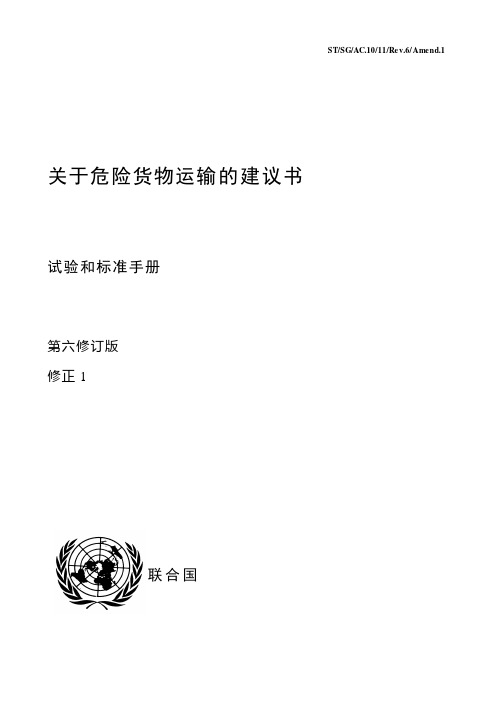
4 ST/SG/AC.10/C.3/100/Add.1,附件二。
对第二部分的修正
第 20 节 .............................................................................................................................. 第 25 节 .............................................................................................................................. 第 28 节 ..............................................................................................................................
第 10 节
10.3.3.2 改为如下: “10.3.3.2 设计用于产生实用爆炸或烟火效果的物质的认可程序从应用试验系列 3 确定 该物 质是
否太敏感不能以其进行试验的形式运输开始。如果该物质通过所有试验,就应适用划定适当项 别 的 程 序。如果该物质没有通过任何一项试验,就不允许以其进行试验的形式运输。没有通过试验类型 3 (c)试 验的物质,可以改性后重新提交进行试验类型 3 (c)的试验。如果物质没有通过试验类型 3 (a)、3 (b)或 3 (d) 的试验,可以对物质加以封装或包装以减少它对外部刺激的敏感度,并提交进行试验类型 4 (b)的试验。”。 10.3.3.4 删除。 10.3.3.3 改排为第 10.3.3.4。
Red Lion 压力蓄储系统所有者手册说明书
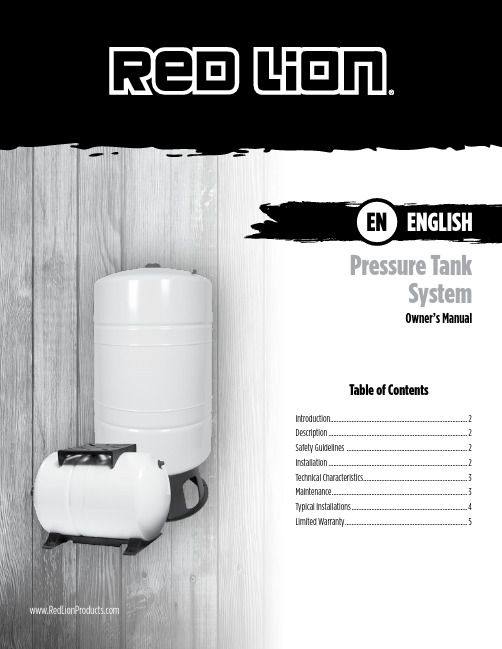
Pressure TankSystemOwner’s ManualENGLISHEN Table of ContentsIntroduction ...................................................................................2Description ....................................................................................2Safety Guidelines .........................................................................2Installation ....................................................................................2Technical Characteristics ...............................................................3Maintenance ..................................................................................3Typical Installations ......................................................................4Limited Warranty .. (5)INTRODUCTIONThis instruction sheet provides you with the information required to safely own and operate your Red Lion® product. Retain these instructions for future reference.The Red Lion product you have purchased is of the highest qual-ity workmanship and material, and has been engineered to give you long and reliable service. Red Lion products are carefully tested, inspected, and packaged to ensure safe delivery and operation. Please examine your unit carefully to ensure that no damage occurred during shipment. If damage has occurred, please contact the place of purchase. They will assist you in replacement or repair, if required.READ THESE INSTRUCTIONS CAREFULLY BEFORE ATTEMPTING TO INSTALL, OPERATE OR SERVICE YOUR RED LION PRODUCT. KNOW THE PRODUCT’S APPLICATION, LIMITATIONS, AND POTENTIAL HAZARDS. PROTECT YOURSELF AND OTHERS BY OBSERVING ALL SAFETY INFORMATION. FAILURE TO COMPLY WITH THESE INSTRUCTIONS COULD RESULT IN PERSONAL INJURY AND/OR PROPERTY DAMAGE!DESCRIPTIONThe Red Lion pressure tank leaves the factory tested and pre-charged. Because air and water are permanently separated, an air volume control is not required.When the pump starts, water enters the tank as system pressure passes the minimum pressure pre-charge. Only usable water is stored. When the pressure in the chamber reaches the pressure switch’s cut-out pressure, the pump stops. (When the tank is installed with a jet pump, the pressure switch is usually installed on the pump.) The tank is filled to the maximum capacity. When water is needed again, pressure in the air side pushes the water in the system.The pressure tank is a closed container. The durable steel shell is constructed in a deep-drawn process for extra strength. Welding eliminates interior rough spots and sharp edges, which prevents damage to the diaphragm. The tank uses a membrane diaphragm to completely isolate compressed air from the water. This diaphragm is made from Butyl approved for potable water. An air charging valve allows the installer to change the air pressure when the tank is empty.SAFETY GUIDELINESThis instruction sheet contains information that is very impor-tant to know and understand. This information is provided for SAFETY and to PREVENT EQUIPMENT PROBLEMS. To help recognize this information, observe the following symbols: DANGER - Indicates an imminently hazardous situation, that,if not avoided, will result in death or serious injury.WARNING - Indicates a potentially hazardous situation, that, if not avoided, could result in death or serious injury. CAUTION - Indicates a potentially hazardous situation, that,if not avoided, may result in minor or moderate injury. NOTICE - Indicates important information that, if not followed, may cause damage to equipment.WARNING: READ AND FOLLOW ALL SAFETY INSTRUCTIONS. Read instructions carefully before attempting to install, operate or service the Red Lion pressure tank. Know the applications, limitations, and potential hazards.WARNING: Read and observe all the notices on the product.CAUTION: Before installing, determine the suitability of the prod-uct for the intended use. User assumes all risk and liability of the application.WARNING: Be sure that electric power to the pump or control box is disconnected before installing or servicing this tank or water system. WARNING: Do not disassemble the pressure tank. WARNING: To guard against equipment damage and/or person-al injury, observe safety precautions and use suitable equipment when moving the tank.WARNING: EXPLOSION HAZARD. This is a diaphragm-type pressure tank. The tank is designed for operation on well water systems limited to the maximum operating pressure indicated on the tank. Never exceed the maximum operating temperature and/ or the maximum allowed pressure indicated on the tank. A 75 PSI SAFETY RELIEF VALVE MUST BE INSTALLED. Any adjustment to the pre-charge must be done prior to installation and at ambi-ent temperature. Do not adjust the pre-charge of this tank if the product is corroded or damaged or shows any signs of diminished integrity. DO NOT ADJUST THE PRE-CHARGE OF THE TANK WITH THE SYSTEM UNDER PRESSURE! Failure to follow these instructions is UNSAFE and may result in serious injury or death and/or property damage. Red Lion does not accept any respon-sibility for damage or injury resulting from improper installation or operation of this tank.WARNING: This tank is intended for use on potable water systems only and any other use may be dangerous and will void the warranty. Do not use the tank with hot water, chemicals, solvents, petroleum products, acids, or any fluids that may be detrimental to the tank. This product’s performance and lifespan can be significantly and adversely impacted by aggressive water conditions. A water test should be conducted at regular, periodic intervals specifically looking for corrosive water, acids, and other relevant water contaminants which, if present, must be treated immediately and appropriately. The system piping must be prop-erly grounded to earth and a dielectric union is recommended in the installation. Failure to follow these instructions may result in serious injury or death and/or property damage.WARNING: Do not use this tank with water containing sand, clay or other solid substances that may damage the tank or the tank’s diaphragm and/or clog its connection. This tank is to be used for storage of well water. Solids in your well water including sand and clay may damage your tank and void the warranty. WARNING: The installation must comply with all national, state, and local plumbing and electric codes.WARNING: Be sure to protect the tank, piping, and all system components from freezing temperatures. Protect the tank from intense cold.WARNING: Install this tank in a well ventilated area, far from heat sources, electric generators, and any other source that may be detrimental to the tank.INSTALLATIONWARNING: EXPLOSION HAZARD. This is a diaphragm-type pressure tank. The tank is designed for operation on well water systems limited to the maximum operating pressure indicated on the tank. Never exceed the maximum operating temperature and/or the maximum allowed pressure indicated on the tank.A 75 PSI SAFETY RELIEF VALVE MUST BE INSTALLED. Any adjustment to the pre-charge must be done prior to installation and at ambient temperature. Do not adjust the pre-charge of this2tank if the product is corroded or damaged or shows any signs of diminished integrity. DO NOT ADJUST THE PRE-CHARGE OF THE TANK WITH THE SYSTEM UNDER PRESSURE! Failure to follow these instructions is UNSAFE and may result in serious injury or death and/or property damage. Red Lion does not accept any responsibility for damage or injury resulting from improper installa-tion or operation of this tank.This product must be installed by a qualified professional following all local and national plumbing and electrical codes.1. I f this tank is replacing a steel galvanized tank, remove existingair volume controls, and remove or plug any bleeder valves, snifter valves, etc.2. D isconnect electric power to the pump or control box beforeinstalling or servicing this tank or water system.3. C ompletely relieve pressure from the water system beforeworking on the water system. Open the faucet nearest the tank and allow the water to drain until the tank is empty.WARNING: Failure to follow these instructions may result in serious injury or death and/or property damage.4. C arefully remove the Red Lion pressure tank from its carton.5. Y our tank is shipped at a reduced pressure setting. It needsto be adjusted to 2 psi below the pressure switch cut-in set-ting (the pressure at which the pump will start). All Red Lion- branded jet pumps include a pressure switch with a cut-in set-ting of 30 psi. Therefore, the pre-charge pressure needs to be adjusted to 28 psi. If your pump is not a Red Lion model, the cut-in setting must be verified. Most pressure switches have the setting marked under their covers. If you cannot determine the settings this way, pressurize the switch and note the cut-in setting. See Table 1 for recommended pre-charge pressure settings. To adjust the tank pressure:a. WARNING: Initial adjustments to the pre-charge must bedone prior to tank installation with tank empty (no water)and with 0 psi pressure on the system. DO NOT ADJUSTTHE PRE-CHARGE OF THE TANK WITH THE SYSTEMUNDER PRESSURE!b. Remove the plastic cap on the air valve of the new system.c. Check the tank pre-charge pressure using a standard tirepressure gauge.d. If required, add air to the tank using a manual bicycle tirepump until the proper pre-charge pressure is reached.Failure to properly adjust the pre-charge will shorten the lifeexpectancy of the tank.e. Replace and tighten the plastic cap on the air valve.6. S elect a location where a water leak will not cause propertydamage and provides adequate means for water drainage.CAUTION: This well tank and the associated piping may in time leak. The manufacturer is not responsible for any water damage that may occur in association with the tank installation. Be sure to protect the tank, piping, and all system components from freezing temperatures.a. Place the tank where it is to be installed. If flooring isuneven, level as necessary.b. Make pipe connections as necessary, in accordance withlocal or state plumbing codes. Ensure the pipe size fromthe tank to the house is the same as the pipe size from thepump to the tank. Refer to the Typical Installations section.c. Prime the pump and restore power (refer to the pumpowner’s manual for instructions).d. Check to ensure joints are airtight. Even a pinhole canprevent proper operation of the pump.TECHNICAL CHARACTERISTICSA label is applied to each pressure tank showing important tech-nical characteristics of the tank: volume, maximum operating temperature, maximum allowed pressure, and pre-charge pres-sure. Always operate your pressure tank within the limits shown on this label. Do not remove or modify this label.CUT-IN PSI CUT-OUT PSI PRE-CHARGE PSI 204018305028406038Table 1Operating PressuresMAINTENANCEThis well tank and the entire system must be checked annu-ally by a qualified professional; visually examine the tank and its connection to the system piping looking for any signs of water leakage or corrosion on the exterior of the tank or the connec-tion. If this water system’s tank shows any visible signs of leaking, corrosion or rusting, the tank must be replaced immediately to avoid personal injury or property damage. Do not adjust the tank air pressure if there are any signs of corrosion on the tank. Failure to follow these instructions may result in serious injury or death and/or property damage.Proper performance of this tank depends on a correct pre-charge of air. When there is no water in the tank, the air pre-charge should be 2 psi below the cut-in pressure setting of the pump pressure switch. Check the tank at least once a year to ensure that the pre-charge pressure is within ±2% of that stated on the identification label:1. D isconnect electric power to the pump or control box beforeinstalling or servicing this tank or water system.2. O pen the faucet nearest to the tank and drain the tank until itis empty. Close the faucet.3. C heck the pre-charge pressure with a standard tire gauge.4. I f necessary, adjust the pre-charge pressure to 2 psi belowpump switch cut-in pressure.5. P rime the pump and reconnect the power (refer to the pumpowner’s manual for instructions).6. C heck to ensure joints are airtight. Even a pinhole canprevent proper operation of the pump.7. T o protect the outside of the tank, periodically clean it usingonly soap and water.WARNING: Do not remove the tank from the water system without completely relieving the pressure and draining the water.34TO HOUSETYPICAL INSTALLATIONSVELOCITY OF 6 FT/SECLIMITED WARRANTYTHIS WARRANTY SETS FORTH THE COMPANY’S SOLE OBLIGATION ANDPURCHASER’S EXCLUSIVE REMEDY FOR DEFECTIVE PRODUCT.The Red Lion brand (hereafter “the Brand”) warrants that the products accompanied by this warranty are free from defects in materials or workmanship of the Brand that exist at the time of sale by the Brand and which occur or exist within the applicable warranty period. Any distributor, sub-distributor, recipient, end-user and/or consumer agrees that by accepting the receipt of the products, the distributor, sub-distributor, recipient, end user and/or consumer expressly agree to be bound by the terms of the warranty set forth herein.I. Applicable Warranty PeriodThe products accompanied by this warranty shall be covered by this Limited Warranty for a period of 60 months from the date of original purchase by the consumer. In the absence of suitable proof of purchase date, the warranty period of this product will begin to run on the product’s date of manufacture.II. Instructions Applicable to this Limited Warranty1. Consumers wishing to submit a warranty claim must return the products accompanied by this warranty to the point of purchasefor warranty consideration.2. Upon discovery of a defect, any personal injury, property damage or any other type of resulting damage, if applicable,shall be reasonably mitigated to the extent possible.3. At its discretion, the Brand may inspect products either at its facilities or in the field, and after determination of a warrantyclaim, will, at its option, repair or replace defective parts. Repaired or replaced parts will be returned freight prepaid by the Brand.4. This warranty policy does not cover any labor or shipping charges. The Brand shall not be liable for any costs or chargesattributable to any product testing, maintenance, installation, repair or removal, or for any tools, supplies, or equipment needed to install, repair, or remove any product.III. Limitations Applicable to this Limited WarrantyTHIS WARRANTY DOES NOT APPLY TO ANY OF THE FOLLOWING:1. Any product that is not installed, applied, maintained, and used in accordance with the Brand’s published instructions, applicablecodes, applicable ordinances and/or with generally accepted industry standards.2. Any product that has been subject to misuse, misapplication, neglect, alteration, accident, abuse, tampering, acts of God(including lightning), acts of terrorism, acts of war, fire, improper storage or installation, improper use, improper maintenance or repair, damage or casualty, or to an excess of the recommended maximums as set forth in the product instructions.3. Any product that is operated with any accessory, equipment, component, or part not specifically approved by the Brand.4. Use of replacement parts not sold by the Brand, the unauthorized addition of non-Brand products to other Brand products,and the unauthorized alteration of Brand products.5. Products damaged by normal wear and tear, normal maintenance services and the parts used in connection with suchservice, o r any other conditions beyond the control of the Brand.6. Any product that has been used for purposes other than those for which it was designed and manufactured.7. Any use of the product where installation instructions and/or instructions for use were not followed.The Brand reserves the right at any time, and from time to time, to make changes in the design and/or improvements upon its product without thereby imposing any obligation upon itself to make corresponding changes or improvements in or upon its products already manufactured and/or previously sold. The Brand further reserves the right to substitute parts or components of substantially equal quality in any warranty service required by operation of this Limited Warranty.This written Limited Warranty is the entire warranty authorized and offered by the Brand. There are no warranties or representations beyond those expressed in this document.THIS WARRANTY AND REMEDY IS IN LIEU OF ALL OTHER WARRANTIES AND REMEDIES INCLUDING, WITHOUT LIMITATION, WARRANTIES OF MERCHANTABILITY AND/OR FITNESS FOR A PARTICULAR PURPOSE, WHICH ARE HEREBY SPECIFICALLY DISCLAIMED AND EXPRESSLY EXCLUDED. CORRECTION OF NON-CONFORMITIES, IN THE MANNER AND FOR THE PERIOD OF TIME AS SET FORTH ABOVE, SHALL CONSTITUTE FULFILLMENT OF ALL LIABILITY OF THE BRAND TO THE PURCHASER WHETHER BASED ON CONTRACT, NEGLIGENCE, OR OTHERWISE.THE BRAND SHALL NOT BE LIABLE FOR INCIDENTAL, CONSEQUENTIAL OR SPECIAL DAMAGES SUCH AS, BUT NOT LIMITED TO:DAMAGE TO OR LOSS OF OTHER PROPERTY OR EQUIPMENT, LOSS OF USE OF EQUIPMENT, FACILITIES OR SERVICE, LOSS OF PROFIT OR SALES, COST OF PURCHASES OR REPLACEMENT GOODS, CLAIMS OF CUSTOMERS OF THE PURCHASER, FAILURE TO WARN AND/OR INSTRUCT, LOSS OF OTHER PRODUCTS, OR COSTS OF ENVIRONMENTAL5REMEDIATION, OR DIMINUTION IN PROPERTY VALUE. THE REMEDIES OF THE PURCHASER SET FORTH HEREIN ARE EXCLUSIVE, AND THE LIABILITY OF THE BRAND SHALL NOT, EXCEPT AS EXPRESSLY PROVIDED HEREIN, EXCEED THE PRICE OF THE PRODUCTS UPON WHICH SUCH LIABILITY IS BASED. DAMAGES AS SET FORTH IN THIS PARAGRAPH SHALL BE REASONABLY MITIGATED TO THE EXTENT POSSIBLE. THIS PARAGRAPH SHALL ALSO APPLY TO ALL DAMAGES RESULTING FROM CONDITIONS SET FORTH IN SECTION III ABOVE AND (1) DEFECTS IN PRODUCT PROTOTYPES OR REPLACEMENT PART PROTOTYPES THAT HAVE NOT BEEN PUT INTO PRODUCTION, CIRCULATED AND SOLD BY THE BRAND, AND/OR (2) DEFECTS THAT WERE NOT FOUND AT THE TIME OF SALE DUE TO SCIENTIFIC AND TECHNOLOGICAL REASONS.This Limited Warranty gives you specific legal rights. You may have other rights, which vary according to the applicable laws and regulations. Where any term of this warranty is prohibited by such laws, it shall be null and void, but the remainder of this warranty shall remain in full force and effect.DISCLAIMER: Any oral statements about the product made by the seller, the Brand, the representatives or any other parties, do not constitute warranties, shall not be relied upon by the user, and are not part of the contract for sale. Seller’s and the Brand’s only obligation, and buyer’s only remedy, shall be the replacement and/or repair by the Brand of the product as described above. Before using, the user shall determine the suitability of the product for his intended use, and user assumes all risk and liability whatsoever in connection therewith.For technical assistance, parts or repair, pleasecontact.... 1.888.956.0000 | Form 998459Rev. 00208/16。
储能器安全操作规程(新版)

( 操作规程 )单位:_________________________姓名:_________________________日期:_________________________精品文档 / Word文档 / 文字可改储能器安全操作规程(新版)Safety operating procedures refer to documents describing all aspects of work steps and operating procedures that comply with production safety laws and regulations.储能器安全操作规程(新版)基本技术参数:控制对象数量:6;畜能器组的可用液量:320L(42.27u.s.gal) 公称压力:21MPa(3000psi);畜能器充氮压力:7MPa(1000psi)电动泵排量:46L/min(6.34u.s.gal/min);电机功率:18.5kw电压:380V;气动泵单个排量:11L/min气动泵单个耗气量:1.5m3/min(114pyd3/min)囊式蓄能器气动油泵输入气源压力:0.8MPa(116psi);输出油压:40MPa(5800psi)电动油泵的启、停控制将远控台上电控箱的主令开关旋至“自动”位置,整个装置便处于自动控制状态。
若系统压力低于19MPa,压力控制器将自动启动电动油泵。
到达21MPa时,压力控制器自动切断电源,使油泵停止供油。
将主令开关旋至“手动”时,按下启动按钮,电动油泵开始供油。
到达21MPa时,应按下“停止”按钮。
注意:液泵不会自动停机,应注意观察系统压力。
气动油泵的控制打开气源开关,关闭液气开关旁通阀,压缩空气进入液气开关,此时管汇压力若低于17.85MPa,液气开关将开启,压缩空气驱动油泵工作。
达到21MPa时,液气开关自动关闭,切断气路,气动油泵停止工作。
储能一体机用户手册

储能一体机用户手册储能一体机用户手册1. 概述储能一体机是一款具有储能功能的综合设备,能够将电能储存起来并在需要时释放。
本用户手册将介绍储能一体机的基本操作和功能。
2. 开始使用2.1 准备工作在开始使用储能一体机之前,确保以下准备工作已经完成:- 将储能一体机连接到电源插座,确保正常供电。
- 将需要储存的电能源(如太阳能板或风能发电机)连接到储能一体机的电源输入端口。
2.2 首次启动第一次启动储能一体机时,按下电源开关,然后等待设备启动完成。
一旦设备启动完成,储能一体机将自动监测输入电能,并开始储存电能。
3. 操作指南3.1 储能模式切换储能一体机可以切换不同的储能模式,以适应不同的需求。
按下模式切换按钮,然后通过显示屏上的菜单选择所需的储能模式。
3.2 储能监测通过显示屏上的监测界面,可以实时监测储能一体机的储能情况。
监测包括储能电压、储能容量和储能效率等参数。
3.3 储能调整根据需要,可以通过显示屏上的调整界面调整储能一体机的储能设置。
可以设置储能容量的大小或调整储能效率等参数。
4. 故障排除如果储能一体机出现故障或异常情况,可以按照以下步骤进行排除:4.1 检查电源连接是否正常,确保储能一体机有稳定的电源供应。
4.2 重启储能一体机,按下电源开关,然后等待设备重新启动。
4.3 如果问题仍然存在,请联系售后服务。
注意:在排除故障过程中,不要打开储能一体机的外壳,以避免触电风险。
除非是专业人员,在没有得到相关指导和许可的情况下,不要尝试修理或更换任何零部件。
本用户手册只是对储能一体机的基本操作和功能进行了简要介绍。
对于更详细的使用指南和技术细节,请参考储能一体机的详细用户手册。
智能电网中的储能系统的使用教程
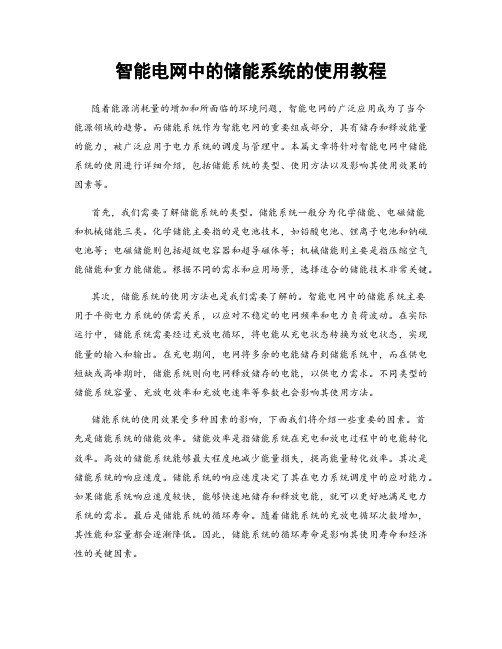
智能电网中的储能系统的使用教程随着能源消耗量的增加和所面临的环境问题,智能电网的广泛应用成为了当今能源领域的趋势。
而储能系统作为智能电网的重要组成部分,具有储存和释放能量的能力,被广泛应用于电力系统的调度与管理中。
本篇文章将针对智能电网中储能系统的使用进行详细介绍,包括储能系统的类型、使用方法以及影响其使用效果的因素等。
首先,我们需要了解储能系统的类型。
储能系统一般分为化学储能、电磁储能和机械储能三类。
化学储能主要指的是电池技术,如铅酸电池、锂离子电池和钠硫电池等;电磁储能则包括超级电容器和超导磁体等;机械储能则主要是指压缩空气能储能和重力能储能。
根据不同的需求和应用场景,选择适合的储能技术非常关键。
其次,储能系统的使用方法也是我们需要了解的。
智能电网中的储能系统主要用于平衡电力系统的供需关系,以应对不稳定的电网频率和电力负荷波动。
在实际运行中,储能系统需要经过充放电循环,将电能从充电状态转换为放电状态,实现能量的输入和输出。
在充电期间,电网将多余的电能储存到储能系统中,而在供电短缺或高峰期时,储能系统则向电网释放储存的电能,以供电力需求。
不同类型的储能系统容量、充放电效率和充放电速率等参数也会影响其使用方法。
储能系统的使用效果受多种因素的影响,下面我们将介绍一些重要的因素。
首先是储能系统的储能效率。
储能效率是指储能系统在充电和放电过程中的电能转化效率。
高效的储能系统能够最大程度地减少能量损失,提高能量转化效率。
其次是储能系统的响应速度。
储能系统的响应速度决定了其在电力系统调度中的应对能力。
如果储能系统响应速度较快,能够快速地储存和释放电能,就可以更好地满足电力系统的需求。
最后是储能系统的循环寿命。
随着储能系统的充放电循环次数增加,其性能和容量都会逐渐降低。
因此,储能系统的循环寿命是影响其使用寿命和经济性的关键因素。
在实际操作中,要正确使用智能电网中的储能系统,需要遵循以下几个步骤。
首先,根据电力系统的需求和储能系统的特点,确定合适的储能技术,并计算所需的容量和数量。
蓄能式液控装置使用说明书
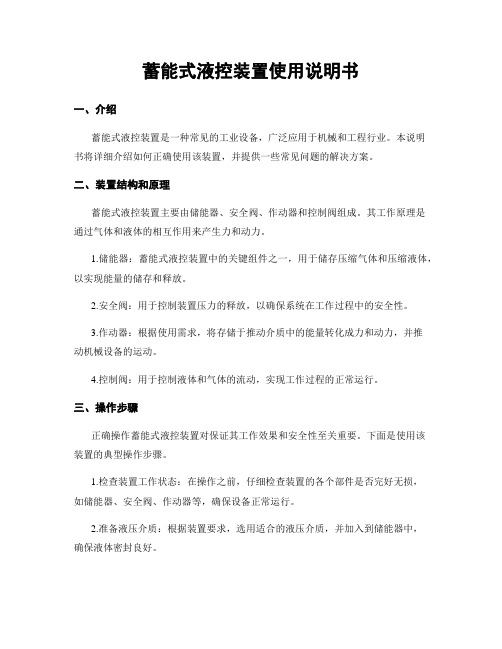
蓄能式液控装置使用说明书一、介绍蓄能式液控装置是一种常见的工业设备,广泛应用于机械和工程行业。
本说明书将详细介绍如何正确使用该装置,并提供一些常见问题的解决方案。
二、装置结构和原理蓄能式液控装置主要由储能器、安全阀、作动器和控制阀组成。
其工作原理是通过气体和液体的相互作用来产生力和动力。
1.储能器:蓄能式液控装置中的关键组件之一,用于储存压缩气体和压缩液体,以实现能量的储存和释放。
2.安全阀:用于控制装置压力的释放,以确保系统在工作过程中的安全性。
3.作动器:根据使用需求,将存储于推动介质中的能量转化成力和动力,并推动机械设备的运动。
4.控制阀:用于控制液体和气体的流动,实现工作过程的正常运行。
三、操作步骤正确操作蓄能式液控装置对保证其工作效果和安全性至关重要。
下面是使用该装置的典型操作步骤。
1.检查装置工作状态:在操作之前,仔细检查装置的各个部件是否完好无损,如储能器、安全阀、作动器等,确保设备正常运行。
2.准备液压介质:根据装置要求,选用适合的液压介质,并加入到储能器中,确保液体密封良好。
3.储能器充气:使用专用充气设备,将压缩气体注入储能器,压力达到装置要求的数值后,关闭充气设备。
4.检查安全阀:确保安全阀的安装正确,并检查其工作状态。
在操作过程中,如果安全阀压力超过设定值,应及时处理并检修。
5.作动器操作:根据使用需求,通过操纵装置控制阀门实现作动器的运动,同时监控液体与气体的流动情况。
6.停止装置:当使用结束或需要停止装置时,首先关闭控制阀,停止液体和气体的流动。
然后等待装置完全停止后,打开放气阀,释放压缩气体。
四、常见问题及解决方案在使用蓄能式液控装置过程中,可能会遇到一些常见问题。
以下列出几个常见问题及其解决方案供用户参考。
1.装置运动失效:检查液体是否流动正常,是否有泄漏现象发生。
同时检查控制阀和作动器是否正常工作。
2.装置声音异常:可能是由于液压介质不足或储能器气压不稳定造成。
安能储能电池安装、操作和维护手册说明书
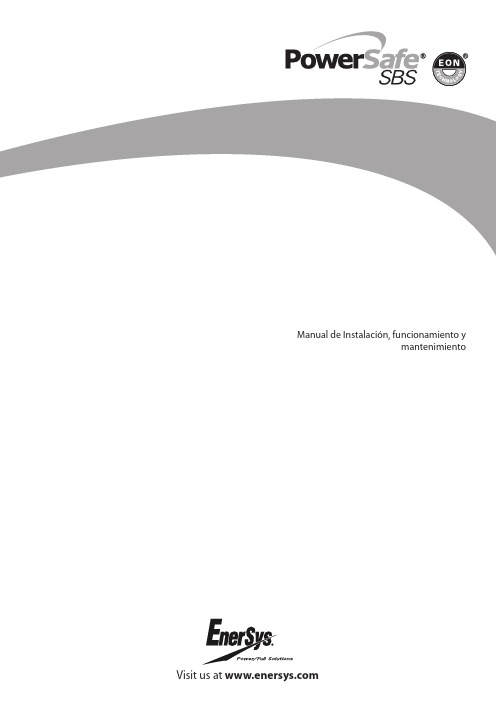
Visit us at ImportanteLea este manual en cuanto reciba la batería, antes de desembalarla e instalarla. El incumplimiento de estas instrucciones anulará y dejará sin efecto cualquier garantía.Las baterías de PowerSafe SBS EON se suministrancargadas y pueden producir cortocircuitos con tensiones extremadamente altas. Tener cuidado de evitar cortocircuitar terminales de polaridad opuesta.Advertencia según Propuesta 65 de California - Los bornes, terminales y accesorios relacionados de la batería contienen plomo y compuestos de plomo, productos químicos indicados por el Estado de California como causantes de cáncer y perjudiciales para la reproducción. Lavarse las manos después de la manipulación.mediante autodescarga. Las temperaturas elevadas aumentan el ritmo de autodescarga y reducen el tiempo de almacenamiento.2.1.1. El diagrama siguiente muestra la relación entre la tensión en circuito abierto (OCV) y el tiempo de almacenamiento a varias temperaturas.2.1.3. Los monobloques y las celdas deben recibir una carga de mantenimiento cuando la tensión en circuito abierto se acerque al equivalente de 2,10 voltios por celda o cuando se alcance el tiempo de almacenamiento máximo, lo que ocurra antes.Cargar los monobloques / las celdas o ramales a una tensión constante equivalente Amp disponible durante un periodo de Antes de que comience el funcionamiento, la batería debe recibir una carga de puesta en servicio. Las baterías deben cargarse utilizando tensión constante con una corriente Amp sin carga conectada a la batería. Puede utilizarse • Carga durante 96 horas a la tensión de flotación recomendada de 2,29 Vpc a 20 °C •C arga durante 24 horas a la tensión de carga rápida recomendada de 2,40 Vpc a 20 °C. Después la batería debe conmutarse a la carga de flotación, manteniendo la batería atensión de flotación durante 24 horas antes de cualquier prueba de descarga.3. Ubicación de la batería El compartimiento/sala de la batería debe tener una ventilación adecuada para limitar la acumulación de hidrógeno. Las baterías deben instalarse de conformidad con la norma IEC 62485-2 y cualquier otra ley y regulación local/nacional.4. Instalación Cualquiera que sea su aplicación, las baterías PowerSafe SBS EON pueden montarse en cualquier orientación excepto invertidas. Sin embargo, en aplicaciones cíclicas, EnerSys recomienda instalar las celdas de tamaño DIN de 2 voltios en orientación horizontal.En esta configuración deben cumplirse las siguientes instrucciones.• No utilice los bornes de terminales para elevar o manipular las celdas.• N o instale las celdas de tal forma que la unión de la tapa de la caja esté reposandoen una corredera.• A segúrese siempre de que la flecha en la tapa de cada unidad esté apuntando enorientación vertical.. Colocar las cubiertas aislantes en posición inmediatamente después de apretar las sujeciones.En caso de sobrecarga accidental, puede salir gas inflamable por el respiradero de seguridad.Descargar cualquier electricidad estática de las ropas tocando una pieza conectada a tierra.Utilizar herramientas con mangos aislantes.No colocar ni dejar caer objetos metálicos sobre la batería.Quitarse anillos, relojes y complementos de vestir que contengan piezas metálicas y que puedan entrar en contacto con los bornes de la batería.Peligro2.1.2. Los tiempos máximos de almacenamiento antes de que necesite una cargaNivel de carga aprox. en %+10 / +504812+15 / +593412+20 / +682412+25 / +77176+30 / +96126+35 / +958.53+40 / +10463T e n s i ón e n c i r c u i t o a b i e r t o p o r c e l d aMesesOCV Audit Interval (Months)+10 / +504812+15 / +593412+20 / +682412+25 / +77176+30 / +96126+35 / +958.53+40 / +10463de mantenimiento y los intervalos recomendados de comprobación de la tensión en circuito abierto son:25. FuncionamientoLas celdas y monobloques con tecnología PowerSafe SBS EON mantienen lascaracterísticas de larga vida útil en flotación y almacenamiento asociadas a las celdas y monobloques tradicionales PowerSafe SBS, con las ventajas adicionales de estar diseñados para aumentar el número de ciclos tanto en modo de carga de flotación como en carga rápida.La batería ofrecerá el mejor rendimiento y la mayor durabilidad cuando se trabaje a una temperatura de 20 °C. El rango máximo de temperatura de funcionamiento es de -40 °C a +50 °C.5.1. Funcionamiento con tensión de flotaciónSe recomienda el uso de cargadores de tensión constante. La tensión de carga debe ajustarse al equivalente de 2,29 Vpc a 20 °C / 68 °F, o bien 2,27 Vpc a 25 °C / 77 °F. La tensión de carga mínima a cualquier temperatura es 2,21 Vpc.La compensación por temperatura de la tensión de flotación recomendada es:• 2,29 Vpc +4 mV por celda por °C por debajo de 20 °C •2,29 Vpc -4 mV por celda por °C por encima de 20 °C5.2. Funcionamiento de carga rápida.La elevada aceptación de carga inherente a la tecnología TPPL empleada en las baterías PowerSafeSBS EON es apta para aplicaciones que requieren un plazo rápido para la repetición del servicio;en tales aplicaciones, la tensión de rectificación debe ajustarse entre 2,35 Vpc y 2,40 Vpc a 20 °C.Una vez que se hayan cargado completamente, la tensión puede cambiarse a la tensión flotante con la compensación de temperatura necesaria.Encontrará más información en la guía para la aplicación PowerSafe SBS EON.5.3. Corriente de cargaDebido a la muy baja resistencia interna, las baterías de PowerSafe SBS EON aceptarán corriente sin límite durante la recarga, pero para fines prácticos y de costes, en aplicaciones de flotación en las cuales el tiempo de recarga para repetir uso no escrítico, la corriente del rectificador puede limitarse a la carga más 0,1 C 10 Amp (mínimo).5.4. DescargaLas baterías no deben dejarse en condición descargada después de suministrar la carga, sino que deben devolverse inmediatamente al modo de recarga.El incumplimiento de estas condiciones puede dar como resultado una durabilidad muy reducida.Para un funcionamiento óptimo la tensión mínima del sistema debe relacionarse con la aplicación de la siguiente forma:5.5. Descarga profunda accidentalEn las aplicaciones cíclicas, con el fin de proteger la batería, es aconsejable disponer de monitorización del sistema y corte de baja tensión (LVD). Debe aplicarse una desconexión de baja tensión de 1,93 Vpc (80 % de profundidad de descarga) para proteger la batería frente a una descarga excesiva.Una excesiva descarga profunda producirá un deterioro prematuro de la batería y una notable reducción de la vida de la batería.5.6. Efecto de la temperaturaEl rendimiento de la batería, en función de diferentes temperaturas, puede calcularse en el programa EnerSys® Battery Sizing (BSP).5.7. Funcionamiento en modo híbridoAdemás de las características de larga vida útil inherentes a los diseños tradicionales de de PowerSafe SBS TPPL, la tecnología EON ha sido desarrollada para proporcionar un elevado rendimiento en aplicaciones donde la batería está sujeta a un ciclo de trabajo repetido o donde la fiabilidad energética es comprobada con temperaturas elevadas y en condiciones adversas en combinación con ubicaciones remotas.En aplicaciones cíclicas, la tensión de carga debe fijarse en el equivalente a 2,40 Vpc a20 °C / 68 °F, con el límite de corriente de rectificación fijado a un mínimo de 0,1C10 A (la tecnología EON está diseñada para aceptar corrientes de entrada ilimitadas sin causar daños en la electroquímica interna).El rendimiento cíclico óptimo se logra devolviendo la batería al estado de cargacompleto entre los ciclos de descarga. Es posible funcionar con celdas y monobloques con tecnología SBS EON en condiciones de estado de carga parcial, sin embargo, en dichas situaciones, es muy importante asegurar que la batería vuelve periódicamente al estado de carga completa para mantener el estado de salud de la batería.Puede encontrar más información en nuestra guía de funcionamiento PowerSafe SBS EON para aplicaciones híbridas.Se recomienda ponerse en contacto con los representantes de EnerSys para obtener información adicional y asesoramiento sobre las aplicaciones en el modo de estado de carga parcial (ECP).”6. MantenimientoEn la práctica, el usuario determina normalmente el programa de mantenimiento en función de la importancia de la instalación, su ubicación y el personal. A continuación, se muestra una sugerencia para el programa de mantenimiento. •Mensual (registro de todas las lecturas)Mida la tensión de la serie de baterías. Si es necesario, ajuste la tensión de flotación al valor correcto. •Cada seis meses (registro de todas las lecturas)Mida la tensión de la serie de baterías. Si es necesario, ajuste la tensión de flotación al valor correcto.Mida las tensiones de los bloques individuales. Los bloques deberían encontrarse en un rango del 5 % con respecto a la media.Compruebe si hay contaminación por polvo o conexiones sueltas o corroídas. Si es necesario, aísle la serie/bloque y limpie con un paño suave humedecido. Advertencia: NO use ningún tipo de aceite, disolvente, detergente, disolvente a base de petróleo o solución de amoniaco para limpiar los recipientes o las tapas de las baterías. Estos productos provocarán un daño permanente al recipiente y la tapa de la batería, lo que invalidará la garantía.Póngase en contacto con EnerSys si tiene alguna duda en relación con el mantenimiento.7. Registro de datosSe recomienda registrar, como mínimo, la siguiente información mediante un registro de datos periódico, que el usuario debe poner a disposición de EnerSys para que se valide cualquier reclamación de garantía:1) Registros de la carga de puesta en servicio.2) Número de ciclos realizados y profundidad de descarga (DoD) de cada ciclo.3) D uración de cada ciclo de descarga y carga, y Ah de entrada y salida (Wh deentrada y salida).4) Datos completos del perfil de tensión/corriente de recarga de los últimos 50 ciclos.5) H istorial completo de las temperaturas ambiente y de superficie de la batería,registradas a intervalos regulares durante el funcionamiento y la vida útil de la batería.6) L a fecha y la hora de cada «evento» (un «evento» se establece al inicio/parada de ladescarga de la batería, al inicio/parada de la recarga de la batería, al inicio/parada de cualquier entrada de alimentación de un generador u otra fuente, etc.).Póngase en contacto con EnerSys si tiene alguna pregunta en relación con el mantenimiento.8. Eliminación de residuosLas baterías PowerSafe SBS EON son reciclables. Las baterías usadas deben embalarse y transportarse de acuerdo con las normas y regulaciones vigentes sobre el s baterías usadas deberán desecharse conforme a las leyes locales y del país en un establecimiento especializado aprobado y certificado para baterías de plomo-ácido.5 min ≤ t ≤ 1h 1.65V 1h ≤ t ≤ 5h 1.70V 5h ≤ t ≤ 8h 1.75V 8h ≤ t ≤ 20h1.80V10/5015/5920/6825/7730/8635/9540/10445/11350/122Recomendada2.33 2.31 2.29 2.27 2.25 2.23 2.21 2.21 2.2131 1 .2 0 2 0。
K60(Rev6-Ch24-MCG)(中文)

第24章多用途时钟信号生成器(MCG)24.1 介绍多用途多用途时钟信号生成器(MCG)模块为MCU提供多种时钟源选项。
这个模块由一个频率环锁(FLL)和一个相位环锁(PLL)组成。
FLL可由一个内部或外部参考时钟控制,而PLL可由一个外部参考时钟控制。
这个模块要么在FLL或PLL输出时钟之间,要么在内部参考时钟或外部参考时钟之间选择一个时钟源以作为MCU系统时钟。
MCG操作与晶体振荡器有关,其中晶体振荡器允许一个外部晶体、陶瓷共振器或外部时钟源产生外部参考时钟。
24.1.1 特性MCG模块的关键特性:◆频率环锁(FLL)。
●数控石晶(DCO)。
●DCO可设置时钟范围有四个。
●低频率外部参考时钟源的编程选项和最大DCO输出频率。
●内外参考时钟可以作为FLL源。
●可以作为其他片上外设的时钟源。
◆相位环锁(PLL)●电压控制振荡器(VCO)●外部参考时钟作为PLL时钟源。
●VCO频分模块。
●相位/频率检测器。
●集成环过滤器。
●可以作为其他片上外设的时钟源。
◆内参考时钟生成器●9个微调位的精确慢时钟●4个微调位的快时钟●可以被用作FLL的时钟源。
在FEI模式下,只有慢内参考时钟(IRC)可以被用作FLL源。
●无论是快时钟还是慢时钟都不能用作MCU的时钟源●可以作为其他片上外设的时钟源。
◆低功耗的石晶时钟发生器位MCG外部参考提供控制信号:●HGO,RANGE,EREFS◆从晶振获得外部时钟●可被用作FLL或PLL的时钟源●可被用作MCU的时钟源◆从RTC获得外部时钟●只能作为FLL的时钟源●只能选择MCU的时钟源◆带有重置请求能力的外部时钟监视器,可以在FBE,PEE,BLPE或者FEE模式下对外部时钟进行监测◆在PLL中使用的有中断请求能力的锁检测器◆外时钟参考的内参考时钟自动裁切功能(ATM)。
◆FLL和PLL的参考分频。
◆为其他片上设备提供时钟源的MCG PLL 时钟(MCGPLLCLK)◆为其他片上设备提供时钟源的MCG FLL时钟(MCGPLLCLK)◆为其他片上设备提供时钟源的MCG Fixed Frequency时钟(MCGPLLCLK)◆为其他片上设备提供时钟源的MCG 内参考时钟(MCGPLLCLK)图24-1 多用途时钟生成器(MCG)框图24.1.2 运行模式MCG共有九中运行模式:FEI,FEE,FBI,FBE,PEE,BLPI,BLPE,和终止模式。
电柜蓄能开关操作方法

电柜蓄能开关操作方法
电柜蓄能开关是一种电气保护设备,用于在电力系统中保护电力设备不受过电流和过电压的损害。
下面是电柜蓄能开关的操作方法:
1. 确认设备正常运转,断开电源后,打开电柜蓄能开关盖板;
2. 检查蓄能器电压是否满足要求,如不足需要进行充电;
3. 检查蓄能器电极是否干净、无氧化;
4. 检查开关机构是否灵活、无卡顿或异响,检查触头不得存在异常磨损和氧化现象;
5. 动作电流超过额定值时,进行手动操作或由保护电路自动操作,使电柜蓄能开关关闭,切断故障电路;
6. 停电后,将蓄能器放电,并关闭电柜蓄能开关盖板。
注意事项:操作时要注意安全,必须按照规定的操作程序进行操作,对电柜蓄能开关进行维护和保养,保证设备的正常运转。
采日能源储能系统说明书
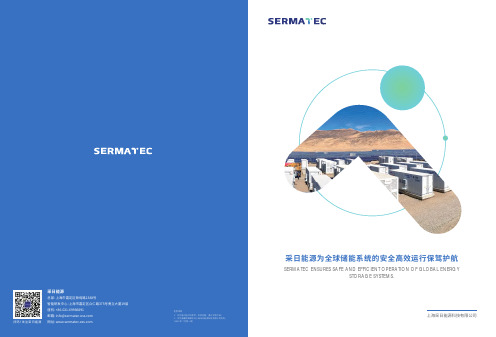
免责申明(2023年7月第一版)总部:智能研发中心:座机:+86-021-********邮箱:*********************网址:上海采日能源科技有限公司关注采日能源采日能源为全球储能系统的安全高效运行保驾护航SERMATEC ENSURES SAFE AND EFFICIENT OPERATION OF GLOBAL ENERGYSTORAGE SYSTEMS.合作伙伴案例介绍PRODUCTION BASEPRODUCT SOLUTIONS生产基地储能解决方案COMPANY PROFILE公司简介01HONORS荣誉资质051008SUCCESSFUL CASES15COOPERATIVE PARTNERS20上海采日能源科技有限公司成立于2017年。
作为一家能源数字化运营和储能系统制造公司,采日能源目前已完成了第二代技术体系的搭建。
围绕“云边端”技术架构,公司将新3S(Security 安全、Standard 标准、Service 服务) 融入到传统3S (BMS、PCS、EMS)中,将生产安全、运行安全,通过核心算法进行技术提升。
自成立以来,公司专注研发创新,成立由200余名技术型人才组成的专业研发团队。
主要产品有发电侧、输配电侧、工商业侧储能系统、户用一体化储能系统、智慧能源运维服务等,可应用于辅助新能源并网、电力调频调峰、需求侧响应、微电网等场景中,覆盖储能产业全生态链。
采日能源严格遵循“责任、荣誉、和谐”的企业精神,立足能源领域,专注研发创新,力求为客户提供卓越品质的产品与服务,为双碳目标及新型电力系统架构的实现贡献力量,为全球储能系统的安全高效运行保驾护航!精神使命责任、荣誉、和谐愿景领先的能源数字化运营商和储能系统制造商为全球储能系统的安全高效运行保驾护航2017采日能源成立,同年确立了以 储能系统安全和效率为核心的3S控制技术架构2019• SMT系列光储一体机获TÜV 认证,新品海外上市• 上海首座标准光储充一体化充电站投运(长江智慧采日)• 国内单体最大的用户侧项目-江苏连云港华乐合金成功并网宁夏市场份额第一荣获 国家高新技术证书、专精特新证书、上海市科学技术奖、AAA级资信等级证书国内用户侧储能市场出货量Top10、全球市场储能系统出货量Top10·电池PACK设计能量管理系统EMS·模块化变流器PCS输配电侧储能解决方案采日能源储能系统可实现增容扩容、备用电源等功能,在输配电侧接纳更多可再生能源,保障电网安全、稳定、 高效、低成本运行。
蓄能器使用说明书

蓄能器使用说明书MGN3N100附录:15160-01-Ⅰ目录:1.简介2.结构与工作原理3.安装4.操作5.维护6.图解1.简介蓄能器作为能量储备应用于液压装置,用于平衡压力和缓冲振动和震荡。
蓄能器通过把一种气体,通常是氮气衬垫,引入液压系统。
这种介质仅能有条件地压缩。
压缩气衬垫能平衡系统压力并且储藏能量。
2.结构与工作原理蓄能器由一个压力容器(07)构成,压力容器里有一个弹性隔间,把液体和压缩气体分隔开。
弹性隔间由合成材料制成,形状像一个气囊(06),通过能使橡胶硬化的阀块(04)与压力容器固定在一起。
压力容器的底部装有一个提升阀(08)。
当系统的压力急剧下降或完全没有压力时,提升阀关闭以免气囊跑出压力容器。
为了避免当压力不稳而快速波动时造成提升阀过载,安装了一个缓冲弹簧。
蓄能器包含有一个充气装置,该充气装置构成:一个带有逆止阀的充气阀,一个安全阀和一个压力表,一根带有接头的高压管用于连接氮气瓶和蓄能器。
当系统的液压液体被推动进入蓄能器时,装有氮气的气囊被压缩,压力增加。
当系统的某个地方需要液压液体时,蓄能器内的那部分液体可以被释放出来。
压缩氮气气囊膨胀推动液体进入液压系统,直到压力达到平衡。
3.安装为了在运输过程中保护好蓄能器气囊不受损坏,已经预先把氮气充入气囊,压力约为10bar。
蓄能器在投入使用之前一定要充气到规定的预充压力P1。
不得超过最大允许压力。
参见铭牌标示。
如果在供货的过程中,蓄能器内的压力已经达到了预充压力P1,液压缸盖(01)密封好,压力规定写在纸片上。
必须严格遵循当地所有的有关压力容器等使用规定。
由于会有爆炸的危险,严厉禁止蓄能器里用氧气或空气代替氮气充装使用。
氮气瓶刷上绿色油漆。
把蓄能器安装好,这样铭牌标志就可以看见了。
要有空间安装充气工具和充气装置。
蓄能器必须装配好。
液体阀(08)的方向必须向下。
蓄能器必须要安装牢固,以免由于震荡导致油管破裂而造成蓄能器的固定夹散开。
Solar Energy Storage系统配置和操作指南说明书

PV Inverter Assistant + General Flag and Generator Start/Stop Virtual switch - Dedicated ignore AC Input
How to charge?
Feed in?
PV Type?
PV
Yes
AC-Coupled
DC-Coupled
No
AC-Coupled
DC-Coupled
OFF-GRID
How to charge?
Feed in?
When genset runs, max pwr
n.a.
AC-Coupled
Otherwise PV
SELF-CONSUMPTION How to charge? PV Only
Feed in? Yes
No
PV Type? AC-Coupled DC-Coupled AC-Coupled DC-Coupled
SELF-CONSUMPTION WITH BATTERY RESERVE FOR GRID FAILURES
DC-Coupled
INTENTIONAL ISLANDING
How to charge?
Feed in?
ncable DC-Coupled
Suggested configuration PV Inverter Support Assistant Hub-1 Assistant "Keep batteries charged" Don't do this, use a MPPT Solar Charge Controller instead. A PV Inverter will want to feed back, and trying to prevent that only complicates the install. Hub-1 Assistant "Connected to mains, no feedback" Hub-4 Assistant. Set the Minimum state of charge in the CCGX to 100% Hub-1 Assistant "Keep batteries charged". Charger tab op 0A to prevent charging from grid (sustain will overrule the max charge current) Consider using an MPPT instead. And if not possible, use Hub-2 Assistant "Connect to AC In when available, keep batteries charged", and enable the prevent feedback setting. Hub-1 Assistant "Connected to mains, no feedback". Charger tab op 0A to prevent charging from grid All Multi settings to default and use the PV Inverter Assistant. Possible connect PV on AC OUT 2 and use an Assistant to disconnect it when the genset is running Option 1) All default Option 2) Hub-1 Assistant "Connected to mains, no feedback". Advantage over option 1 is that PV power will be used when available, instead powering all loads with genset
标准款储能安全操作及保养规程
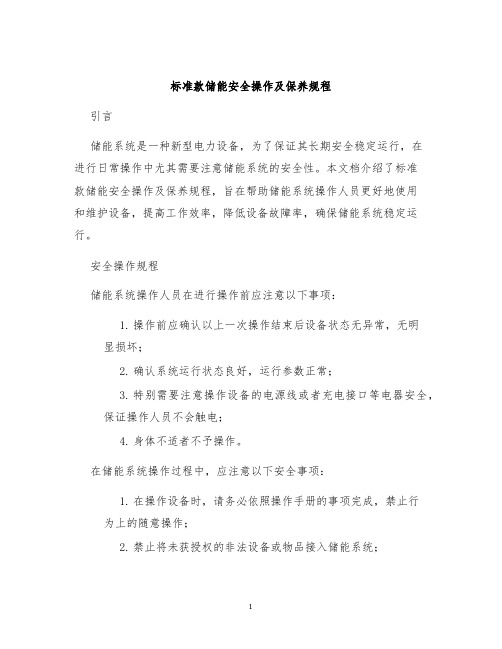
标准款储能安全操作及保养规程引言储能系统是一种新型电力设备,为了保证其长期安全稳定运行,在进行日常操作中尤其需要注意储能系统的安全性。
本文档介绍了标准款储能安全操作及保养规程,旨在帮助储能系统操作人员更好地使用和维护设备,提高工作效率,降低设备故障率,确保储能系统稳定运行。
安全操作规程储能系统操作人员在进行操作前应注意以下事项:1.操作前应确认以上一次操作结束后设备状态无异常,无明显损坏;2.确认系统运行状态良好,运行参数正常;3.特别需要注意操作设备的电源线或者充电接口等电器安全,保证操作人员不会触电;4.身体不适者不予操作。
在储能系统操作过程中,应注意以下安全事项:1.在操作设备时,请务必依照操作手册的事项完成,禁止行为上的随意操作;2.禁止将未获授权的非法设备或物品接入储能系统;3.操作人员应经常检查设备运行状态,确保设备运行平稳,无异常,若发现问题应及时工单维修,以免产生意外;4.维修人员在对设备进行维修时,应先断开电源并通知操作人员,这样确保操作人员无法误操作。
保养规程为确保储能系统长期稳定工作,需要定期对设备进行保养。
保养规程如下:1.首先对设备进行清洁,防止储能系统受到异物损坏;2.定期检查设备的运行参数,对于超出规定范围的参数,及时采取措施修复;3.定期更换电池,保证电池的性能正常;4.定期检查设备的安全性,保证设备本身没有问题;5.定期检查应急备用电源,保证在发生普通停电时,储能系统能够顺利转为备用电源,并在停电期间正常供电。
结语本文档详细介绍了标准款储能安全操作及保养规程,希望操作人员们能够认真遵守,保障设备的稳定运行。
同时本文档不时更新,以适应储能系统的最新要求,若对本文档存在疑问,欢迎通过指定联系方式与作者联系。
电池储能系统安全操作规程
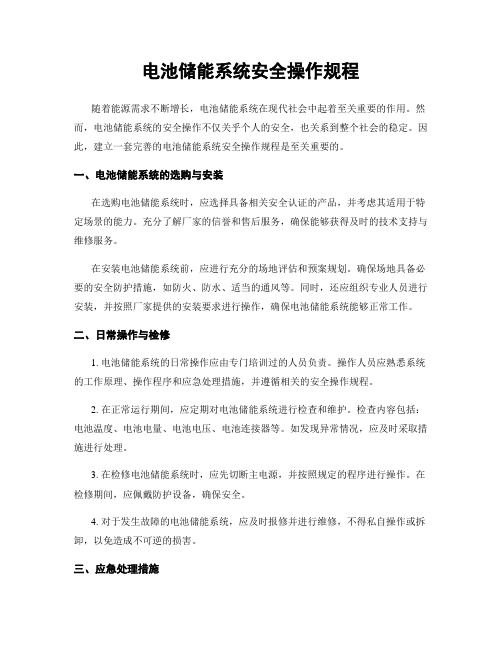
电池储能系统安全操作规程随着能源需求不断增长,电池储能系统在现代社会中起着至关重要的作用。
然而,电池储能系统的安全操作不仅关乎个人的安全,也关系到整个社会的稳定。
因此,建立一套完善的电池储能系统安全操作规程是至关重要的。
一、电池储能系统的选购与安装在选购电池储能系统时,应选择具备相关安全认证的产品,并考虑其适用于特定场景的能力。
充分了解厂家的信誉和售后服务,确保能够获得及时的技术支持与维修服务。
在安装电池储能系统前,应进行充分的场地评估和预案规划。
确保场地具备必要的安全防护措施,如防火、防水、适当的通风等。
同时,还应组织专业人员进行安装,并按照厂家提供的安装要求进行操作,确保电池储能系统能够正常工作。
二、日常操作与检修1. 电池储能系统的日常操作应由专门培训过的人员负责。
操作人员应熟悉系统的工作原理、操作程序和应急处理措施,并遵循相关的安全操作规程。
2. 在正常运行期间,应定期对电池储能系统进行检查和维护。
检查内容包括:电池温度、电池电量、电池电压、电池连接器等。
如发现异常情况,应及时采取措施进行处理。
3. 在检修电池储能系统时,应先切断主电源,并按照规定的程序进行操作。
在检修期间,应佩戴防护设备,确保安全。
4. 对于发生故障的电池储能系统,应及时报修并进行维修,不得私自操作或拆卸,以免造成不可逆的损害。
三、应急处理措施1. 对于电池储能系统的火灾风险,一旦发生火灾,应立即切断电源,并使用合适的灭火器材进行灭火。
如火势无法控制,应立即撤离现场并呼叫消防队伍进行处理。
2. 运行中的电池储能系统出现泄漏等情况时,应立即切断电源,并采取相应的对策,如密封泄漏处、通风等。
在处理泄漏物时,应佩戴防护手套和防护眼镜,避免直接接触泄漏物。
3. 在发生地震、台风等自然灾害时,应保持电池储能系统正常运行状态,并按照应急预案进行相应的处理,以确保系统的安全运行。
四、维护与更新1. 定期维护电池储能系统的设备,保证设备的正常运行。
STM6600-STM6601_rev6_中文_数据手册

STM6600 STM6600
不成功上电 不成功上电
(PB 在 tON_BLANK (tON_BLANK 在 PB
之前释放) . . . 释放前结束). .
.
.
..
...
.
.
.
.
..
...
.
.
.
.
..
...
.
.
.
.
..
...
.
.
.
.
..
...
.
.
.
.
..
...
.
.
.
.
16
. 17
STM6601 成功上电 . . . . . . . . . . . . . . . . . . . . . . . . . . . . . . . . . . . . . . . . . . . . . . . . . . . . . . 18
STM6600 成功上电 (PB 在 tON_BLANK 结束前释放) . . . . . . . . . . . . . . . . . . . . . . . . . . . . 14
STM6600 成功上电 (tON_BLANK 在 PB 释放前结束) . . . . . . . . . . . . . . . . . . . . . . . . . . . . 15
STM6601 不成功上电 . . . . . . . . . . . . . . . . . . . . . . . . . . . . . . . . . . . . . . . . . . . . . . . . . . . . . 19
伴有电压降低的 STM660x 上电 . . . . . . . . . . . . . . . . . . . . . . . . . . . . . . . . . . . . . . . . . . . . . 20
电子储能装置使用方法说明书

电子储能装置使用方法说明书【注意事项】1. 在使用电子储能装置之前,请仔细阅读本说明书。
2. 请确保您已正确理解并能正确使用电子储能装置。
3. 限制儿童接触电子储能装置,避免触电或其他意外伤害。
4. 如设备发生故障,请务必立即停止使用,并联系专业人员进行维修检查。
5. 禁止在高温、潮湿或易燃易爆环境中使用电子储能装置。
6. 请勿将电子储能装置随意拆卸或改动,以免引起故障或安全隐患。
7. 如需长时间存放电子储能装置,请将其放在干燥通风的地方。
【产品介绍】电子储能装置为便携式的储能设备,适用于各种电子设备,如手机、平板电脑、摄像机等。
其体积小巧,重量轻便,容易携带。
采用可充电电池储存电能,通过USB线或其他适配器进行充电。
【充电方法】1. 将电子储能装置插入电源,确保供电正常。
2. 使用配套的USB线或其他适配器,将其一端连接到电子储能装置的充电端口,另一端插入电源插座,开始充电。
3. 在充电过程中,可以通过电子储能装置上的指示灯判断充电进度。
当指示灯变为常亮或熄灭时,即表示充电完成。
4. 充电完成后,拔出USB线或适配器,断开电源。
【使用方法】1. 将需要充电的电子设备通过USB线或其他适配器连接到电子储能装置的输出端口。
2. 打开电子储能装置的电源开关。
3. 确保电子储能装置有足够的电能,以满足需要充电的设备。
4. 在设备充电过程中,可以通过电子储能装置上的指示灯判断其电能消耗情况。
当指示灯开始闪烁或熄灭时,表示电能即将耗尽,建议及时充电。
5. 电子储能装置内部配备了多种保护机制,如过流保护、过压保护等,保证充电过程的安全稳定。
如遇到异常情况,电子储能装置会自动停止充电,避免对设备和使用者构成损害。
6. 电子储能装置支持同时为多个设备充电,但请注意合理分配电能,避免过度消耗。
【常见问题解决】1. 电子储能装置不能正常充电或无法输出电能时,检查是否已连接好USB线或适配器,确保电子储能装置与电源接触良好。
- 1、下载文档前请自行甄别文档内容的完整性,平台不提供额外的编辑、内容补充、找答案等附加服务。
- 2、"仅部分预览"的文档,不可在线预览部分如存在完整性等问题,可反馈申请退款(可完整预览的文档不适用该条件!)。
- 3、如文档侵犯您的权益,请联系客服反馈,我们会尽快为您处理(人工客服工作时间:9:00-18:30)。
楼房入户式储能蓄电系统用户手册2014年 8月目录1.注意事项…………………………………………………………………………2.快速安装指南………………………………………………………………………3.概述……………………………………………………………………………………4.用途……………………………………………………………………………………5.主要特性………………………………………………………………………………6.主要技术规格…………………………………………………………………………7.设备功能………………………………………………………………………………8.系统操作说明…………………………………………………………………………9.系统运行步骤……………………………………………………………………………10.常见报警说明及处理方法………………………………………………………………11.维护保养……………………………………………………………………一注意事项:1、非专业人员请不要自行打开机箱。
2、在额定功率范围内使用。
3、该电源系统在使用过程中有一定的发热量属正常现象、但要保持安装环境的通风散热、干净清洁,特别不能阻塞通风孔。
4、必须按照说明之要求使用。
安全预防信息当您使用本产品时,牢记下列安全措施,可避免发生火灾,电击或其它人身伤害的可能性。
1、阅读并理解本使用手册的全部内容。
2、任何时候,都使用一般常识去操作电气部件。
3、遵从产品及附带的印刷品中标注的警告事项及说明。
4、当操作说明与安全信息发生冲突时,请遵从安全信息,请注意您是否误解了操作说明的内容。
如果您不能断定问题所在,请向销售商或工厂寻求支援。
5、产品重量和体积较大,搬动过程避免跌碰撞。
6、请注意不要将产品靠近或放在发热体、取暖器、空调器或排气管道上。
7、本逆变器必须安装在牢固的水平面上,电源线及电池线要牢固,并能防止老鼠等动物的破坏。
8、安装地请远离水,蒸汽和其它液体物质,远离易燃易爆物质。
9、请不要使用电源线超载工作,避免火灾及电击事故发生。
10、为了避免发生电击事故,不要随意拆卸本产品。
需要维修时,请寻求有资格的专业人员帮助。
11、请保存好用户手册,作为日后参阅。
二、快速安装指南用户只要接3组线就可正常使用本系统:1.AC INPUT接市电,注意L、N、E接线顺序,特别注意E不能接L、N上.2.SOLAR充电线与太阳能板相连,注意正负极不能接反.3.AC OUTPUT接用电设备, 注意L、N、E接线顺序,特别注意E不能接L、N上.不能超功率使用. 用户连接OK后,按下开启按钮,就可设置操作本系统.三、概述楼房入户式储能蓄电系统可以利用太阳能发电装置,以及风力发电机产生的能源,还有社会供电系统的低价电力来源把富裕电力存入储能系统,以备高峰时使用,不仅可作应急电源,更能为家庭节省电力开支,该系统具有体积小、智能供电、显示直观、操作简便等优点,是楼房入户式用电系统中不可缺少的供电系统。
系统是由控制模块,逆变器模块,锂电池以及锂电池管理系统综合组成四、用途1、可用于用户后备供电电源;2、可用于储能和智能选用供电电源,降低供电成本。
3、可用于远程控制,以降低电场辐射对人体影响。
五、主要特性1、供电电源可以智能选择供电电源;2、由七寸LCD屏显示工作参数和工作模式,简洁直观;3、工作模式和工作时间由人及交互界面设定,方便快捷;4、系统采用嵌入式编程,安全可靠;5、系统可对工作参数和工作状态进行实时显示和监控;6、具有过压、过流,欠压报警监控功能。
7、系统具有电池过放、过流多重保护功能;8、产品重量轻、寿命长、环保无污染。
六、主要技术规格七、设备功能7.1主控系统1.7.2 BMS电池组电压电池组实际容量工作电流电池组单体最高电压电池组单体最低电压温度(检测电池组温度)充电机电池信息菜单键编号(显示电池组单体最低电压模块编号)编号(显示电池组单体最高电压模块编号)图标说明主控制操作界面BMS操作界面开机按钮关机按钮电池信息界面主要显示电池组每个单体电芯的电压和模块的温度菜单键充电机图标说明电池组实际容量电池组电压工作电流返回编号(显示电池组单体最高电压模块编号)BMS 本面配置子菜单BMS 配置界面子菜单编号(显示电池组单体最低电压模块编号)电池信息电池组单体电池电压(主要检测每个单体电芯的电压)返回上一页下一页模块温度过充释放电压欠压释放电压 过温释放温度 过充保护电压 读取写入高温保护温度 过放保护电压欠压报警电压 恢复默认返回过放释放电压充电最大电流 充电截止电流 最大满充电压 满充释放总压读取写入返回系统设置:触摸声音设置系统语言设置时间设置主界面模式设置坐标调整系统待机返回菜单7.3.接线端口介绍背面接线图主控制系统BMSUPS电池电池1). 主控制器接线端AC 市电(+)AC 市电(-)地线UPS (+)UPS (-)充电器(+)充电器(-)DC 太阳能(+)DC 太阳能(-)电池(+)电池(-)地线空气开关通讯端口交流输出口主控充电电流采样主控与UPS 通讯+AC 输出互感主控放电电流采样2) MBS接线端电池(-)电池(+)DC(-)DC(+)充电器(-)电池(-)充电器(+)电池(+)主控充电电流采样BMS主从通讯主控放电电流采样3) UPS接线端主控与UPS通讯+AC输出互感AC输入(+)AC输入(-)AC输出(+)AC输出(-)风扇(+)风扇(-)DC(-)DC(+)4)电池接线端电池(-)电池(-)电池(+)电池(+)BMS主从通讯BMS主从通讯模式一:AC 模式1、 定时充电功能:用户可设定一个低价用电时间段来充电储。
缺省设置: 23:00-7:00。
由 AC TO DC 模式对电池充电。
AC 市电输入(+)AC 市电输入(-)地线太阳能输入(+)太阳能输入(-)空交流输出(+)交流输出(-)地线2、定时放电功能:用户可设定一个时间段来放电。
缺省设置:7:00-23:00。
通过DC TO AC模式对负载供电;3、当电池放到10%时,自动切换到市电,即BY PASS模式。
在人机界面上显示电池低电压.4、除设定定时充放电功能外,用户可随时通过人机界面,手动切换充放电功能。
模式二:SOLAR模式在此模式下,系统根据设定的电压值来使用电池逆变,如设置电池在51V以上开启电池逆变,当电池低到48V自动切换到市电,当太阳能对电池充到51V会再次开启逆变,以节省电网用电。
模式三:AC+SOLAR模式八.系统操作说明●开机画面:八.系统操作说明按下左边开启按钮,且长按5-7秒钟。
开机后显示开机画面并读取3秒钟进入主界面● 主界面123456进入主界面时显示:1):自动与手动切换按钮2):系统参数设置按钮3):电池参数设置按钮 4):充电器充电按钮 5):市电供电按钮 6):UPS 输出控制按钮● 手动控制:进入手动界面显示: 1)点击,电池给负载供电12345 62)点击,市电给负载供电。
3)点击,充电器给电池充电4)点击,修改控制系统参数。
弹出密码输入界面:输入密码:123456(初始密码),点击Enter键进入参数修改主界面:①点击或即可对电池充放电时间段进行设置弹出参数设置界面:输入参数后点击Enter键,再点击,即设定成功。
点击可以取消当前充放电时间段设置。
②系统时间校正设置点击,弹出系统时间对话框:当需要修改年月日当中的某一项时,可点击相应的数字,如需要修改年份,即点击,弹出参数修改界面:输入参数后,点击Enter键,再点击即修改成功。
③系统语言设置:点击,即可切换为其他语言。
点击Ruturn即可回到主界面。
5)点击弹出密码输入界面:输入密码:123456(初始密码),点击Enter键进入参数修改主界面:①模式设置点击按钮可进行运行模式选择,点击此按钮,会从“AC input mode”→“Solar input mode”→“AC/Solar input mode”循环切换②保护参数设置电池放电保护电压。
当电池电压低于这个值时,电池停止放电,转为市电供电,此参数也可以在太阳能模式下设置。
电池恢复放电电压值,当电池因充电达到这个设定值时,重新开启电池放电功能. 此参数也可以在太阳能模式下设置.电池最大放电电流保护参数,当电池放电电流高过此设定值时,转到市电供电,以保护电池.UPS最大放电电流保护参数,当UPS放电电流高过此设定值时,系统关闭,转到手动状态,用户需确认用电器功率是过大或有电路短路现象.点击上的数字,即可弹出参数修改界面:输入参数后点击Enter键,即设定成功。
③密码修改设置点击按钮,进入密码修改界面点击上的数字进行新密码修改,点击Enter点击进行密码确认,点击enter。
再点击密码即修改成功。
⑤放电容量设置点击,可修改预留容量百分比。
此容量是设置预留容量在紧急情况下使用,如果电池容量低于设定值,系统会停止电池放电,转到市电工作.当出现停电情况下,系统会以此预留容量逆变输出.如果不需预留,设为0%即可。
点击即可返回主界面。
●自动控制:点击主界面上的,即进入自动控制状态。
BMS系统操作说明:●开机界面:长按左边开启按钮,且长按5-7秒钟。
开机后显示开机画面3秒钟进入主画面;●主界面1)点击,①设置本机配置:点击进入修改界面:1.点击可以切换触摸声音的打开和关闭。
2.点击可以将系统语言切换为英文或中文。
3.点击,进入选择界面:切换界面类型4.点击,进入界面:点击界面上的数字如,即弹出修改操作界面:输入参数,点击Enter键,再点击“读取”即修改成功。
5.点击,界面进入黑屏状态:再次点击屏幕即可恢复。
6.点击,进入坐标调整界面:2)点击,进入模块1界面点击,进入模块2界面可以查看模块温度和各模块单体电压具体数据。
3)充电机设置点击点击,进入界面:方便查看充电机工作状态是否正常以及温度,电压,电流的具体数据。
点击,进入界面:点击界面上的数字如,弹出修改界面:输入修改参数,点击Enter键,再点击“读取”即可修改成功。
4)点击,进入界面;当储能蓄电系统出现异常情况会有报警提示(出现相应图标),此界面即可根据图表查看所对应的具体原因。
九、系统运行步骤1、依附件说明连接电路,通电前检查系统电路,确保电路连接正确;2、启动开关按钮,检查控制器和BMS是否工作正常;3、手动模式运行系统,观察系统是否运行正常;4、设定自动模式下的电池充放电时间,然后校准系统时钟,点击自动运行按钮,系统进入到自动运行模式;5、系统无报警,则进入正常运行状态;6、需人工控制时,进入手动状态,点击控制开关,即可对相应电器进行通断控制。
十、常见报警说明及处理方法当逆变电源出现故障不能正常工作时,请您对照使用手册的说明处理,如果仍然不能解决,请尽快与经销商或厂家联系,切勿自行拆卸零件!十一、维护保养为了保证系统连续正常运行,要求经常进行维护和保养。
